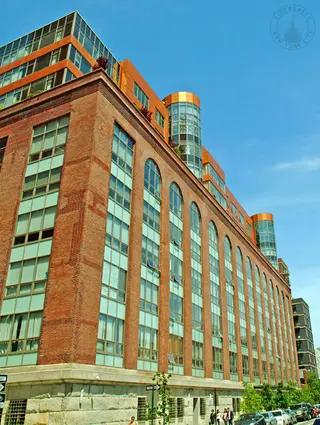 Carter Horsley
Carter HorsleyJun 27, 2013
Carter's Review
The Powerhouse at 50-09 Second Street in Long Island City, Queens, is a former electrical powerhouse whose four, 275-foot-high chimneys have been chopped off.
The building, which is also known as 2-17 51st Street, was developed by CGS Developments and Zigmond Brach.
It was designed by McKim, Mead & White in 1909 to provide electricity for trains.
It was converted to a residential condominium in 2008 and has 177 apartments, of which 16 are duplexes.
Karl Fischer was the architect for the residential conversion. Andres Escobar did the interiors.
Bottom Line
The bases of the chimneys have been incorporated into the design of this former industrial building, giving it some interesting apartments and a distinctive appearance. The building is close to the Gantry Plaza state Park and the Vernon Jackson subway station.
Description
Four setback stories were added to the original plant building, which closed in 1920.
The red-brick building has numerous arched windows and is distinguished by the cylindrical living rooms created from the bases of the chopped-off smokestacks.
Amenities
The building has a handsome roof deck with stunning vistas of Midtown Manhattan, a doorman, a screening room, cold storage, a children’s playroom, a bicycle room, a garage, a gym known as the Aqua Grotto with a large whirlpool, waterfall and swimming pool and a live-in superintendent.
Apartments
Some apartments have 20-foot-high ceilings and some have arched windows. All apartments have American walnut floors, video intercoms and quartzite countertops with a wenge wood breakfast bar.
Bathrooms have double sinks, rain showers.
Apartment 805 is a two-bedroom unit with 15-foot-long dining room with an open pass-through kitchen and a circular living room 17 feet in diameter that opens onto a 590-square-foot terrace.
Apartment 202 is a one-bedroom unit that has a small entry foyer that leads past an 11-foot-long home office to a pass-through kitchen and a 12-foot-long dining room and a circular living room 17 feet in diameter surrounded on three sides by a 254-square-foot terrace.
Apartments 910-1010 are three-bedroom units with diagonal entry foyers that leads to 17-foot-wide dining rooms with open kitchens with an island and a circular dining room with a 17-foot diameter.
Apartments 909-1009 are two-bedroom units with a diagonal entry foyer that leads to a 18-foot-long dining room with an open pass-through kitchen to a circular living room with a 17-foot-diameter.
Apartment 221 is a one-bedroom unit with a 26-foot-long living/dining room and an open kitchen and 495-square-foot terrace.
Apartments 903-1103 are two-bedroom units with 19-foot-long living/dining rooms with open kitchens with an island.
History
The developers originally planned to demolish the entire building but later changed their plans.
An early photograph shows the building with its four enormous smokestacks connected to a spindly tower on the riverfront with a conveyor bridge to the top floor of the plant. The development’s website notes that the engineering firm of Westinghouse, Church, Kerr & Co., was also involved in the building’s design for the electrification and expansion of the Long Island and Pennsylvania Railroads.

- Condo built in 1906
- Converted in 2008
- 1 apartment currently for sale ($975K)
- Located in Long Island City
- 177 total apartments 177 total apartments
- 10 recent sales ($715K to $1.3M)
 6sqft delivers the latest on real estate, architecture, and design, straight from New York City.
6sqft delivers the latest on real estate, architecture, and design, straight from New York City.
